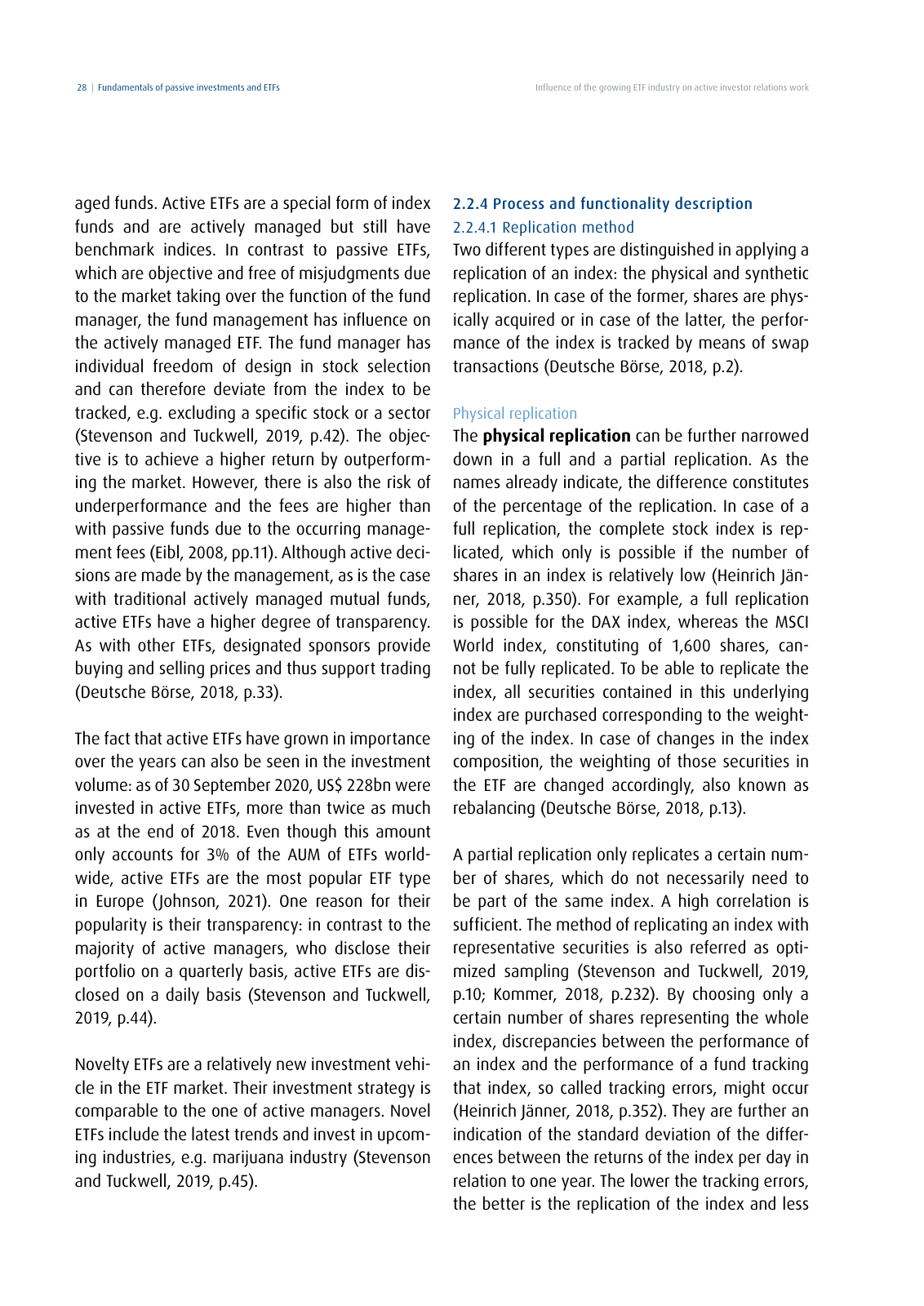Influence of the growing ETF industry on active investor relations work28 Fundamentals of passive investments and ETFs aged funds Active ETFs are a special form of index funds and are actively managed but still have benchmark indices In contrast to passive ETFs which are objective and free of misjudgments due to the market taking over the function of the fund manager the fund management has influence on the actively managed ETF The fund manager has individual freedom of design in stock selection and can therefore deviate from the index to be tracked e g excluding a specific stock or a sector Stevenson and Tuckwell 2019 p 42 The objec tive is to achieve a higher return by outperform ing the market However there is also the risk of underperformance and the fees are higher than with passive funds due to the occurring manage ment fees Eibl 2008 pp 11 Although active deci sions are made by the management as is the case with traditional actively managed mutual funds active ETFs have a higher degree of transparency As with other ETFs designated sponsors provide buying and selling prices and thus support trading Deutsche Börse 2018 p 33 The fact that active ETFs have grown in importance over the years can also be seen in the investment volume as of 30 September 2020 US 228bn were invested in active ETFs more than twice as much as at the end of 2018 Even though this amount only accounts for 3 of the AUM of ETFs world wide active ETFs are the most popular ETF type in Europe Johnson 2021 One reason for their popularity is their transparency in contrast to the majority of active managers who disclose their portfolio on a quarterly basis active ETFs are dis closed on a daily basis Stevenson and Tuckwell 2019 p 44 Novelty ETFs are a relatively new investment vehi cle in the ETF market Their investment strategy is comparable to the one of active managers Novel ETFs include the latest trends and invest in upcom ing industries e g marijuana industry Stevenson and Tuckwell 2019 p 45 2 2 4 Process and functionality description 2 2 4 1 Replication method Two different types are distinguished in applying a replication of an index the physical and synthetic replication In case of the former shares are phys ically acquired or in case of the latter the perfor mance of the index is tracked by means of swap transactions Deutsche Börse 2018 p 2 Physical replication The physical replication can be further narrowed down in a full and a partial replication As the names already indicate the difference constitutes of the percentage of the replication In case of a full replication the complete stock index is rep licated which only is possible if the number of shares in an index is relatively low Heinrich Jän ner 2018 p 350 For example a full replication is possible for the DAX index whereas the MSCI World index constituting of 1 600 shares can not be fully replicated To be able to replicate the index all securities contained in this underlying index are purchased corresponding to the weight ing of the index In case of changes in the index composition the weighting of those securities in the ETF are changed accordingly also known as rebalancing Deutsche Börse 2018 p 13 A partial replication only replicates a certain num ber of shares which do not necessarily need to be part of the same index A high correlation is sufficient The method of replicating an index with representative securities is also referred as opti mized sampling Stevenson and Tuckwell 2019 p 10 Kommer 2018 p 232 By choosing only a certain number of shares representing the whole index discrepancies between the performance of an index and the performance of a fund tracking that index so called tracking errors might occur Heinrich Jänner 2018 p 352 They are further an indication of the standard deviation of the differ ences between the returns of the index per day in relation to one year The lower the tracking errors the better is the replication of the index and less

Hinweis: Dies ist eine maschinenlesbare No-Flash Ansicht.
Klicken Sie hier um zur Online-Version zu gelangen.
Klicken Sie hier um zur Online-Version zu gelangen.